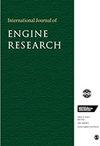具有 eBoost 辅助功能的柴油机充气系统的 LQTI 增压压力和 EGR 率控制
IF 2.1
4区 工程技术
Q2 ENGINEERING, MECHANICAL
引用次数: 0
摘要
涡轮增压柴油发动机通常会因所谓的涡轮迟滞而出现明显的响应延迟,尤其是大排量发动机。因此,人们开发了许多技术来减少涡轮迟滞。本文为配备 eBoost(电动压缩机)系统的柴油发动机开发了一种协调控制策略,以显著减少涡轮迟滞。本文针对福特 6.7 L 8 缸柴油发动机开发了一种多输入多输出 (MIMO) 线性二次跟踪积分 (LQTI) 控制策略及其调度逻辑,该发动机配备了可变几何形状涡轮增压器 (VGT)、废气再循环 (EGR),并增加了 eBoost 和旁通阀。请注意,现有的量产发动机没有 eBoost 和旁通阀。根据相关线性化模型,在不同的发动机运行条件下设计了多个基于模型的 LQTI 控制器,并根据发动机负载条件和旁通阀位置安排控制输出。所开发的控制策略在模拟和实验研究中都得到了验证,测试结果表明,与生产配置(不带 eBoost 和旁通阀)相比,在负荷阶跃后达到目标进气歧管(增压)压力方面,发动机响应时间最多可缩短 81.36%,且对氮氧化物排放无明显影响。本文章由计算机程序翻译,如有差异,请以英文原文为准。
LQTI boost pressure and EGR rate control of a diesel air charge system with eBoost assistance
Turbocharged diesel engines often suffer significant response delay due to so-called turbo-lag, especially engines with large displacement. For this reason, many technologies have been developed to reduce turbo-lag. This paper develops a coordinated control strategy for a diesel engine equipped with an eBoost (electrical compressor) system to significantly reduce turbo-lag. A multiple-input and multiple-output (MIMO) Linear Quadratic Tracking with Integral (LQTI) control strategy, along with its scheduling logic, is developed for the Ford 6.7 L 8-cylinder diesel engine equipped with a variable geometry turbocharger (VGT), exhaust gas recirculation (EGR), and added eBoost along with a bypass valve. Note that the existing production engine does not have an eBoost and bypass valve. Multiple model-based LQTI controllers were designed at different engine operational conditions based on the associated linearized models, and the control outputs are scheduled based upon the engine load condition and bypass valve position. The developed control strategy is validated in both simulation and experimental studies, and the test results show a reduction in engine response time by up to 81.36% in terms of reaching target intake manifold (boost) pressure following a load step-up, compared with the production configuration (without eBoost and bypass valve) with no significant impact on NOx emissions.
求助全文
通过发布文献求助,成功后即可免费获取论文全文。
去求助
来源期刊

International Journal of Engine Research
工程技术-工程:机械
CiteScore
6.50
自引率
16.00%
发文量
130
审稿时长
>12 weeks
期刊介绍:
The International Journal of Engine Research publishes high quality papers on experimental and analytical studies of engine technology.
 求助内容:
求助内容: 应助结果提醒方式:
应助结果提醒方式:


